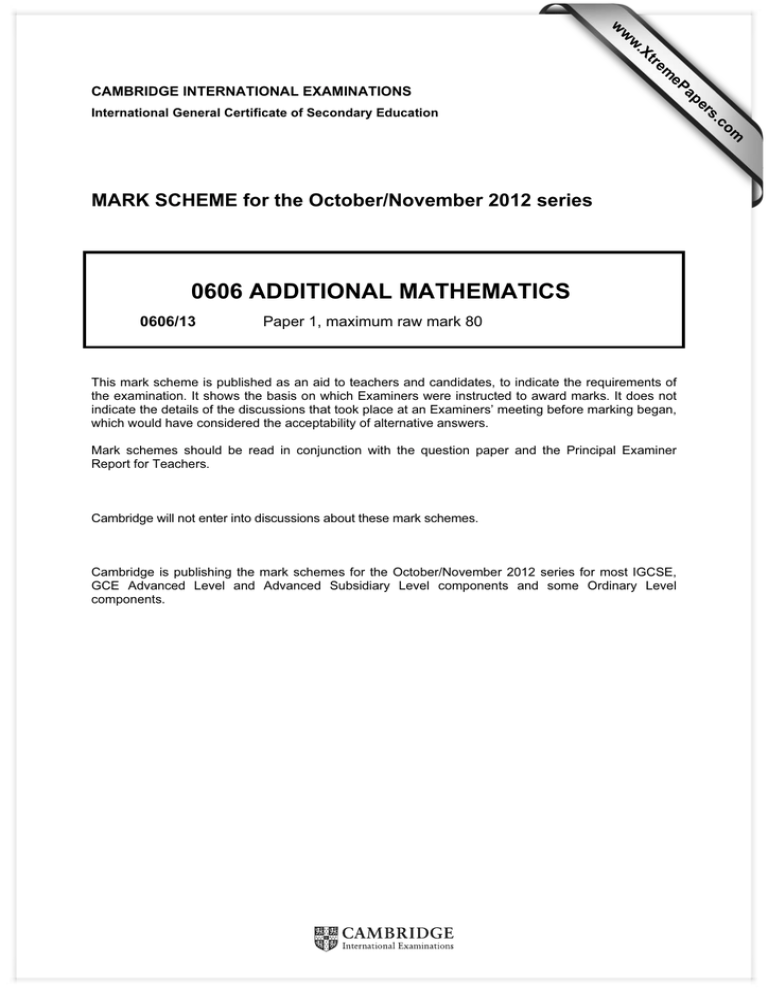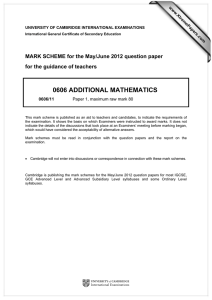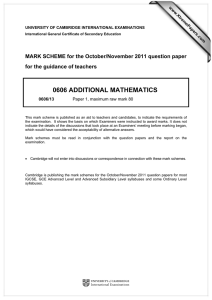0606 ADDITIONAL MATHEMATICS MARK SCHEME for the October/November 2012 series
advertisement

w
w
ap
eP
m
e
tr
.X
w
CAMBRIDGE INTERNATIONAL EXAMINATIONS
0606 ADDITIONAL MATHEMATICS
0606/13
Paper 1, maximum raw mark 80
This mark scheme is published as an aid to teachers and candidates, to indicate the requirements of
the examination. It shows the basis on which Examiners were instructed to award marks. It does not
indicate the details of the discussions that took place at an Examiners’ meeting before marking began,
which would have considered the acceptability of alternative answers.
Mark schemes should be read in conjunction with the question paper and the Principal Examiner
Report for Teachers.
Cambridge will not enter into discussions about these mark schemes.
Cambridge is publishing the mark schemes for the October/November 2012 series for most IGCSE,
GCE Advanced Level and Advanced Subsidiary Level components and some Ordinary Level
components.
om
.c
MARK SCHEME for the October/November 2012 series
s
er
International General Certificate of Secondary Education
Page 2
Mark Scheme
IGCSE – October/November 2012
Syllabus
0606
Paper
13
Mark Scheme Notes
Marks are of the following three types:
M
Method mark, awarded for a valid method applied to the problem. Method marks are
not lost for numerical errors, algebraic slips or errors in units. However, it is not
usually sufficient for a candidate just to indicate an intention of using some method or
just to quote a formula; the formula or idea must be applied to the specific problem in
hand, e.g. by substituting the relevant quantities into the formula. Correct application
of a formula without the formula being quoted obviously earns the M mark and in some
cases an M mark can be implied from a correct answer.
A
Accuracy mark, awarded for a correct answer or intermediate step correctly obtained.
Accuracy marks cannot be given unless the associated method mark is earned (or
implied).
B
Accuracy mark for a correct result or statement independent of method marks.
•
When a part of a question has two or more “method” steps, the M marks are generally
independent unless the scheme specifically says otherwise; and similarly when there are
several B marks allocated. The notation DM or DB (or dep*) is used to indicate that a
particular M or B mark is dependent on an earlier M or B (asterisked) mark in the scheme.
When two or more steps are run together by the candidate, the earlier marks are implied and
full credit is given.
•
The symbol √ implies that the A or B mark indicated is allowed for work correctly following
on from previously incorrect results. Otherwise, A or B marks are given for correct work
only. A and B marks are not given for fortuitously “correct” answers or results obtained from
incorrect working.
•
Note:
B2 or A2 means that the candidate can earn 2 or 0.
B2, 1, 0 means that the candidate can earn anything from 0 to 2.
© Cambridge International Examinations 2012
Page 3
Mark Scheme
IGCSE – October/November 2012
Syllabus
0606
Paper
13
The following abbreviations may be used in a mark scheme or used on the scripts:
AG
Answer Given on the question paper (so extra checking is needed to ensure that
the detailed working leading to the result is valid)
BOD
Benefit of Doubt (allowed when the validity of a solution may not be absolutely
clear)
CAO
Correct Answer Only (emphasising that no “follow through” from a previous error
is allowed)
ISW
Ignore Subsequent Working
MR
Misread
PA
Premature Approximation (resulting in basically correct work that is insufficiently
accurate)
SOS
See Other Solution (the candidate makes a better attempt at the same question)
Penalties
MR –1
A penalty of MR –1 is deducted from A or B marks when the data of a question or
part question are genuinely misread and the object and difficulty of the question
remain unaltered. In this case all A and B marks then become “follow through ”
marks. MR is not applied when the candidate misreads his own figures – this is
regarded as an error in accuracy.
OW –1,2 This is deducted from A or B marks when essential working is omitted.
PA –1
This is deducted from A or B marks in the case of premature approximation.
S –1
Occasionally used for persistent slackness – usually discussed at a meeting.
EX –1
Applied to A or B marks when extra solutions are offered to a particular equation.
Again, this is usually discussed at the meeting.
© Cambridge International Examinations 2012
Page 4
1
Mark Scheme
IGCSE – October/November 2012
Syllabus
0606
Paper
13
(a)
B1
B1
[2]
(b) (i) F ⊂ B, B ⊃ F, F ⊆ B and B ⊇ F,
F ∩ B = F or F ∪ B = B
(ii) S ∩ F = ∅, S ∩ F = {} or
n(S ∩ F) = 0
2
(i) 3 or
(ii)
B1
[1]
B1
[1]
3
1
B1
[1]
dy 3 sin t 3 sin t
=
=
dx 4 cos 2 t
3
π
3 sin
6
=
3
= 0.5
M1 correct substitution in
M1
dy dy dt
o.e.
= ×
dx dt dx
DM1
A1
DM1 for use of their ‘3’ and substitution of
[3]
3
(i)
(ii)
15
6
C 7 = 6435
B1
C 2 × 9C 5 = 1890
M1,A1
π
.
6
[1]
M1 for a correct method
[2]
(iii) No women: 9 C 7 = 36
6435 – 36
= 6399
B1 for 9 C 7 = 36
M1 for a complete, correct method
B1
M1
A1
[3]
4
(i)
4
B1 for y = tan x
B1
B1, B1
y
3
2
y = 1 + 3sin 2 x
1
x
45
90
135
180
–1
–2
–3
–4
[3]
π
3π
(ii) , 4 and , − 2
4
4
B1 for shape of curve
B1 for a ‘curve’ starting at 1 and finishing at 1
and going between 4 and –2.
B1 for each or B1 for both x coordinates
correct
B1, B1
[2]
(iii) 3
Ft from their (i) or correct
B1ft
[1]
© Cambridge International Examinations 2012
Page 5
5
Mark Scheme
IGCSE – October/November 2012
(i)
Syllabus
0606
Paper
13
B1
B1 for correct triangle
Could be implied by subsequent working.
320
80
=
sin 120° sin α
M1
M1 for complete method (sine rule and/or
cosine rule) to find α or β
α = 12.5° (or β = 47.5°)
A1
A1 for α (or β )
Bearing = 042.5° or 043°
A1
80
β
80
α
α
320 or 320
β
80
A1 for bearing
[4]
(ii)
vr
320
, v r = 272.4
=
sin 47.5° sin 120°
or
x
450
=
sin 120° sin 47.5°
Time =
M1
M1 for use of complete method (sine rule
and/or cosine rule) to find vr
or x
For either v = 272 or x = 529
A1
450
528.6
or
272.4
320
= 1.65
450
their velocity
x
or their
320
DM1 for
DM1
A1
[4]
6
( p + x )6 = p 6 + 6 p 5 x + 15 p 4 x 2 + 20 p 3 x 3 ...
(i)
3
15 p 4 = × 20 p 3 ,
2
B1 for 15 p 4 , B1 for 20 p 3
M1 for correct attempt to equate
B1, B1
M1
A1
p=2
[4]
(ii) need p 6 ( 1 ) + 6 p 5 ( − 2 ) + 15 p 4 ( 1 )
B1 for both p 6 , 6 p 5 (allow in (i))
B1
2
= – 80
M1
A1
[3]
1
M1 for attempt using 3 terms for 1 − and
x
identifying and adding at least two terms
independent of x
© Cambridge International Examinations 2012
Page 6
7
Mark Scheme
IGCSE – October/November 2012
(
)
dx t 2 + 1 − t ( 2t )
=
2
dt
t 2 +1
(i)
(
A1
dx
1
When
= 0, t = 1 so x =
dt
2
DM1
A1
(ii)
(
t 2 +1
d x
=
dt 2
2
)
2
( − 2t ) − (1 − t 2 ) 4t ( t 2 + 1 )
(t
2
+1
)
DM1 for equating to zero and attempt to solve
to find t.
1
A1 for x =
2
[4]
M1
M1 for attempt to differentiate a quotient or
product to find acceleration
A1 correct unsimplified
4
A1
When t = 1, acceleration = – 0.5
Paper
13
M1 for attempt to differentiate a quotient or
product
A1 all correct, allow unsimplified
M1
)
Syllabus
0606
A1
[3]
8
(i) f(2) = 24 + 20 + 2p + 8 = 0
M1 for use of 2 and equating to zero, or use of
comparing coefficients or algebraic long
division
M1
p = – 26
A1
a = 3, b = 11, c = −4
B3
(ii) ( x – 2 ) ( 3x – 1 ) ( x + 4 )
M1
A1
B1 for each of a, b and c
[5]
M1 for attempt to obtain 3 factors
[2]
9
(i)
AD 2 = 20 2 + 10 2 − 2 ( 20 )( 10 ) cos
5π
6
M1 finding AD using cosine rule including
square root.
B1 for either arc length
M1
B1
Perimeter =
10 π 20 π
+
+ 2 ( 29.1 )
6
6
= 73.9
DM1
DM1 for correct plan before evaluation using
correct arc lengths and AD
Awrt 73.9
A1
[4]
(ii) Area =
1 2 π 1 2 π 1
5π
10 + 20 + 2 ( 10 )( 20 ) sin
6
2
6 2
6 2
M1
M1 for area of triangle using the sine rule, or
complete correct method
B1 for ½ 102(π/6) or ½ 202(π/6)
DM1 for correct plan before evaluation using
correct sector and triangle areas.
Awrt 231
B1
DM1
= 231
A1
[4]
© Cambridge International Examinations 2012
Page 7
Mark Scheme
IGCSE – October/November 2012
10 (i) (sec2 x – 1) – 2sec x + 1 = 0
sec x (sec x – 2) = 0
cos x = 0.5, x = 60°, 300°
Syllabus
0606
Paper
13
M1 for use of correct identity
M1 for solution of quadratic in sec or cos
A1 for one correct solution
M1
M1
A1, A1
[4]
Alt scheme:
sin 2 x
2
−
+1= 0
2
cos
x
cos x
sin2 x – 2 cos x + cos 2 x = 0,
cos x = 0.5, x = 60°, 300°
(ii)
M1 for dealing with tan and sec correctly and
for use of correct identity
M1 for solution to obtain cos x
1
1
tan 2 3 y = , tan 3 y = ( ± )
5
5
1
(or sin 3 y = ( ± )
, cos 3 y = ( ± )
6
3y = 0.42, 2.72, etc.
y = 0.140, 0.907, 1.19, 1.95
5
6
M1
M1 for correctly obtaining in terms of 1 trig
ratio and square rooting
M1
A1, A1
M1 for dealing with ‘3’ correctly
A1 for first A1 for others
)
[4]
π 2
(iii) sin z + =
4 5
π
z + = 0.4115, 2.730, 6.695
4
z = 1.94, 5.91
11 EITHER
dy
(i)
= 5e x − 3e − x
dx
3 dy
=− 2
When x = 1n ,
5 dx
3
When x = 1n , y = 8
5
3
Tangent: y − 8 = − 2 x − 1n
5
3
(3.49)
When y = 0, x = 4 + 1n
5
(ii)
a
∫ 5e + 3e
[5e − 3e ]
x
−x
dx = 12
M1
M1 for dealing with ‘2’ and cosec correctly
DM1
DM1 for dealing with
A1,A1
π
correctly
4
[4]
B1
B1 For correct derivative
B1
B1 for grad = –2 from correct working
B1
B1 for y = 8
M1
Equation of a tangent using their gradient and
their 8
A1
[5]
B1
B1 for correct integration
5e a − 3e −a − 2 = 12
M1
M1 for correct use of limits
5e 2 a − 14e a − 3 = 0
A1
Answer given so need to see some
manipulation
0
x
−x
a
o
= 12
[3]
(iii)
( 5e
a
)
+ 1 ) (e a − 3 = 0
a = ln 3 , 1.1 or 1.10
M1
M1
A1
M1 for recognising and dealing with quadratic
M1 for correct method of solution to obtain a
[3]
© Cambridge International Examinations 2012
Page 8
11 OR
(i)
Mark Scheme
IGCSE – October/November 2012
(
)
(
dy 1 + e 2 x 6e 2 x − 3e 2 x 2e 2 x
=
2
dx
1+ e 2x
(
)
)
M1
A2,1,0
Syllabus
0606
Paper
13
M1 for attempt to differentiate a quotient or
product
–1 each error
6e 2 x
(1 + e )
2x 2
∴A=6
A1
For 6 obtained from correct working.
[4]
(ii) When x = 0, y =
dy 3
=
dx 2
3
2
B1 for y =
B1
A
4
A
Ft their y0 and
4
B1 for grad =
B1ft
3 3
∴ y− = x
2 2
3
2
B1ft
[3]
(iii)
1 e 2x
dx =
2 1+ e 2x
e 2x
∫ (1 + e )
(
2x 2
)
( + c)
M1
M1 for attempt at ‘reverse differentiation’
3
Ft on their A, i.e.
for a correct statement
A
A1ft
1n 3
1 e 2x
1 9 1
= −
2x
2 1+ e 0
2 10 2
= 0.2
(
)
M1
M1 for correct use of limits
A1ft
Ft
[4]
A
30
© Cambridge International Examinations 2012





